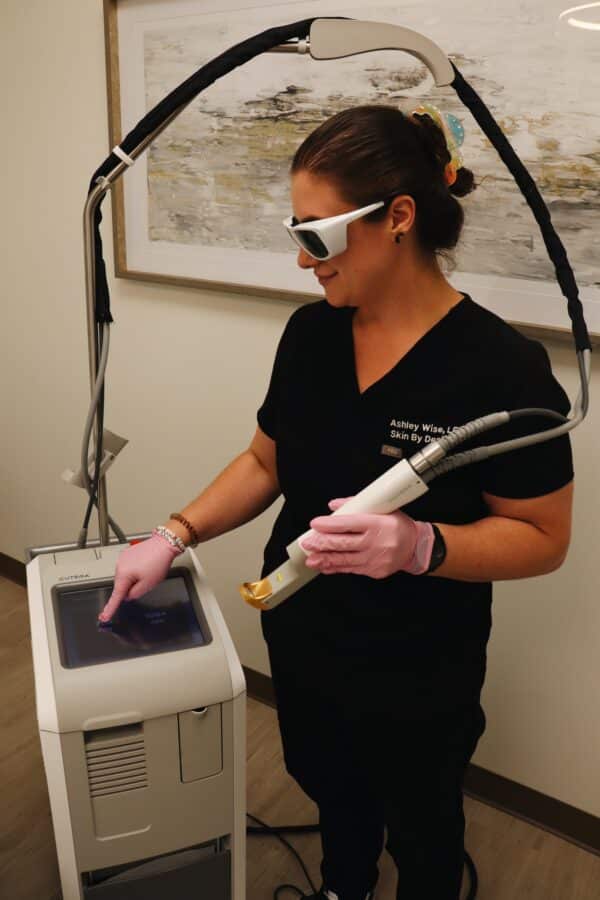
Cosmetic hair removal refers to professional treatments designed to remove or reduce unwanted hair from various parts of the body. These treatments are usually longer-lasting than methods like shaving or waxing and are often used for areas where people want more permanent results, such as the face, legs, or bikini line. Unlike temporary solutions, cosmetic hair removal involves techniques that target the hair follicle to prevent future growth, providing semi-permanent or permanent hair reduction.
Laser Hair Reduction:
Laser hair reduction is a popular cosmetic treatment that uses focused light to remove unwanted hair. The laser emits concentrated light that is absorbed by the pigment (melanin) in the hair follicles. The light energy is converted into heat, which damages the follicle and inhibits future hair growth.
Here's a detailed breakdown of how laser hair reduction works:
How It Works:
- Targeting the Hair Follicles: The laser targets the pigment in the hair, specifically melanin, which is present in darker hair. The laser light is absorbed by the pigment and travels down the hair shaft to the follicle, where it is converted into heat.
- Damage to the Follicle: The heat generated from the laser destroys the hair follicle, preventing it from growing new hair. The laser doesn't affect the surrounding skin, but it disables the follicle's ability to produce hair in the future.
- Selective Targeting: The laser is designed to specifically target hair, so it's effective at damaging hair follicles without harming the surrounding skin. This makes it an efficient method for hair removal.
Procedure:
- Consultation: Before undergoing laser hair removal, a consultation with a certified specialist is required. They will assess your skin type, hair color, and the area to be treated to determine if you're a good candidate.
- Preparation: The area to be treated will be cleaned, and protective eyewear will be given to shield your eyes from the laser light. In some cases, a topical numbing cream may be applied to reduce discomfort.
- Laser Treatment: During the treatment, a handheld laser device will be moved across the treatment area. The laser will emit pulses of light, which may feel like a light snap or slight tingling on the skin. Depending on the area, each session can take anywhere from a few minutes to an hour.
- Post-Treatment Care: After the treatment, you may experience redness or swelling in the treated area, similar to a mild sunburn. This typically resolves within a few hours to a day. The technician may apply a soothing gel or cooling treatment to reduce discomfort.
Effectiveness:
- Multiple Sessions: Laser hair removal typically requires multiple sessions (usually 6 to 8) spaced several weeks apart. Hair grows in different stages, and the laser is most effective on hairs that are in the active growth phase (anagen phase). Since not all hairs are in the same growth phase at the same time, multiple sessions are necessary for optimal results.
- Long-Term Results: While laser hair removal can lead to permanent hair reduction, it's important to note that complete hair removal is not always guaranteed. Some individuals may experience regrowth, but it is typically finer and lighter than before. For some people, maintenance sessions are required to keep hair regrowth to a minimum.
Electrolysis:
Electrolysis is a professional hair removal treatment that uses an electric current to permanently remove unwanted hair. It's the only FDA-approved method for permanent hair removal, making it a highly effective and trusted option for individuals who want long-term results. Electrolysis can be used on various areas of the body and face, and it works on all hair and skin types.
How It Works:
- A very fine probe (similar to a needle) is inserted into the hair follicle.
- Once the probe is in place, an electric current is passed through the probe into the hair follicle. This current destroys the follicle by :
- Heat energy (in thermolysis or short-wave diathermy)
- The current or heat destroys the root of the hair, effectively preventing further hair growth.
- After the follicle is destroyed, the hair is carefully removed using tweezers.
Procedure:
- Consultation: Before the first treatment, you'll have a consultation with a certified electrolysis technician. They’ll evaluate your hair and skin type and discuss your goals. The technician will also explain the process and any aftercare required.
- Treatment Session:
- The area to be treated is cleaned.
- The probe is inserted into each individual hair follicle.
- The electric current is applied, and the hair is removed with tweezers.
- Each hair follicle is treated separately, so this process is time-consuming and works best for small to medium-sized areas like the face, underarms, or bikini line.
Pain and Discomfort:
- Most people experience mild discomfort during the procedure, described as a slight tingling or pinching sensation.
- Depending on the area being treated and your pain tolerance, the technician may apply a topical numbing cream to minimize discomfort.
Duration of Treatment:
- Sessions typically last between 15 minutes to 1 hour, depending on the size of the treatment area.
Multiple Sessions are required, as hair grows in different stages, and electrolysis is most effective during the active growth phase of the hair cycle. You may need 5–15 sessions to achieve permanent results for any given area.
